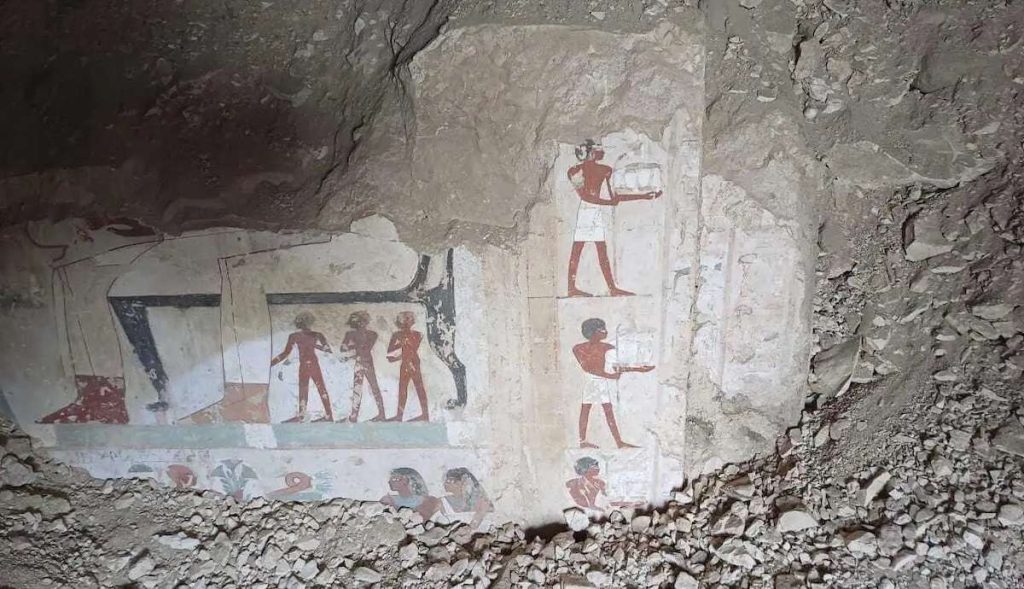# Three Ancient Egyptian Tombs Unearthed in Luxor
By Emily Snow | Published: May 27, 2025
Egyptian archaeologists have made an exciting discovery in Luxor—three 3,000-year-old tombs belonging to high-ranking officials from the New Kingdom era. The tombs, filled with hieroglyphs and artifacts, offer a fascinating glimpse into the lives of Egypt’s elite during one of its most powerful periods.
A Major Archaeological Find
The newly uncovered tombs were found in the Dra’ Abu El-Naga necropolis, a burial site near the famous Karnak Temple and the Valley of the Kings. This area has long been a hotspot for archaeologists, as it was a prestigious burial ground for nobles and officials rather than royalty.
An all-Egyptian excavation team led the dig, uncovering well-preserved hieroglyphic inscriptions and funerary objects. The tombs date back to the New Kingdom period (1550–1070 BCE), a time when Egypt was at the height of its power, wealth, and cultural influence.
Egypt’s Minister of Tourism and Antiquities, Sherif Fathy, called the discovery “significant” for the country’s archaeological record. This find follows another major announcement earlier this year—the discovery of the tomb of King Thutmose II, an 18th Dynasty pharaoh.
Who Was Buried in These Tombs?
Thanks to the hieroglyphic inscriptions inside the tombs, archaeologists have identified the names and titles of the three individuals buried there:
1. Amun-em-Ipet – Likely lived during the 19th or 20th Dynasty and served in the Temple of Amun, the most important religious site in ancient Egypt. Scenes in his tomb depict furniture carriers and a banquet, though much of the artwork has faded over time.
2. Baki – A granary supervisor from the 18th Dynasty, responsible for managing Egypt’s vital grain supplies. His tomb provides clues about the economic and administrative roles of officials during this era.
3. Es – Also from the 18th Dynasty, Es held multiple prestigious titles, including supervisor of the Temple of Amun, mayor of the northern oases, and royal scribe. His tomb suggests he was a highly respected figure in both religious and governmental affairs.
What Was Found Inside the Tombs?
The tombs contained a variety of artifacts, including:
– Funerary figurines (shabtis) – Small statues meant to serve the deceased in the afterlife.
– Pottery and offering vessels – Used in burial rituals to honor the dead.
– Hieroglyphic inscriptions – Providing names, titles, and religious texts to guide the deceased into the afterlife.
While some of the tomb decorations have deteriorated over time, the surviving inscriptions and objects offer valuable insights into burial customs, religious beliefs, and daily life in ancient Egypt.
What’s Next for the Discovery?
Mohamed Ismail Khaled, Secretary-General of Egypt’s Supreme Council of Antiquities, stated that further research and restoration work will be needed to fully understand the tombs’ significance. Archaeologists will continue studying the inscriptions and artifacts to piece together more details about these officials and their roles in society.
This discovery also comes as Egypt prepares for the full opening of the Grand Egyptian Museum (GEM), which will house over 100,000 ancient artifacts. While the museum has partially opened to the public, its official launch date is still pending.
Why This Discovery Matters
1. Expands Our Knowledge of the New Kingdom – The tombs provide new information about high-ranking officials who played key roles in Egypt’s administration and religion.
2. Highlights Non-Royal Burials – While royal tombs like those in the Valley of the Kings get much attention, discoveries like these shed light on the lives of Egypt’s elite beyond the pharaohs.
3. Boosts Egypt’s Archaeological Tourism – With Egypt working to revive its tourism industry, major finds like this attract global interest.
Final Thoughts
The discovery of these three tombs in Luxor is another thrilling chapter in Egypt’s rich archaeological history. As researchers continue to study the site, we can expect even more revelations about the lives, beliefs, and legacies of these ancient Egyptian statesmen.
For now, the world watches as Egypt uncovers more of its buried treasures—one tomb at a time.
Stay tuned for more updates on this fascinating discovery!
—
Like this article? Share it with fellow history lovers!
Sources:
– Egypt Ministry of Tourism and Antiquities
– Associated Press (AP)
Tags: #AncientEgypt #Archaeology #Luxor #NewKingdom #Egyptology #History



support our project
At History Affairs, we believe history belongs to everyone.
donateYour contribution helps us keep this global archive open, free, and growing — so people everywhere can learn from the past and shape a better future.
lastest
Britain’s Pension Trap: Why Every Government Flinches
The Decembrists: Russia’s First Liberal Revolt and the Winter It Failed
Miranda Kaufman’s Heiresses: A review
How TV Rewrite the Norman Conquest
Christianity at the Crossroads by David N. Hempton: A Review
Strabo: The Man Who Wrote the World for Empire
Derek R. Peterson’s A Popular History of Idi Amin’s Uganda: A Review
Joyce Butler and the Long Road to the UK Sex Discrimination Act 1975
How Early England Kept Time
reading more
Canada’s Historic Treasures: 5 Must-Visit National Historic Sites
Players in the Guildhall
Pope Alexander VI and the Scandalous Borgia Legacy
The Tobacco Coast: Shaping Early America
How the 12th Century Invented the “Enemies” of Medieval Europe
The Sophists, Socrates, and the Quest for Moral Clarity
Understand the Biblical Symbolism of Prostitution
Napoleonic Battlefields to Visit: Austerlitz, Borodino, Leipzig & Waterloo
Druids and the Soul of Wales
The Assassination of Caesar: Why the Ides of March Mattered
Key Issues Shaping U.S. Presidential Elections
“Crazy Judah” and the Railroad That United America